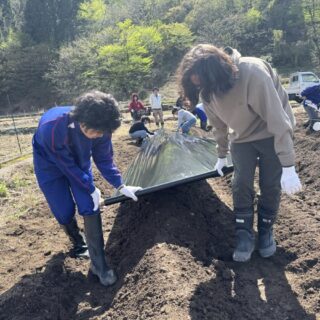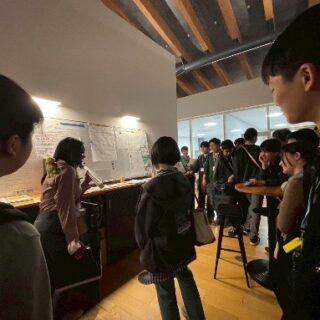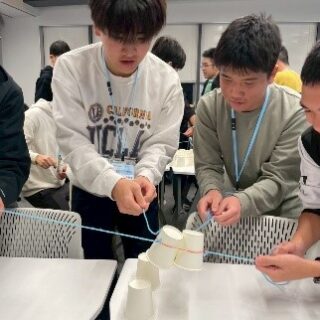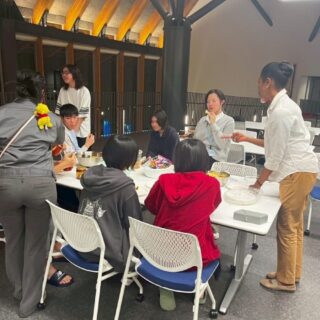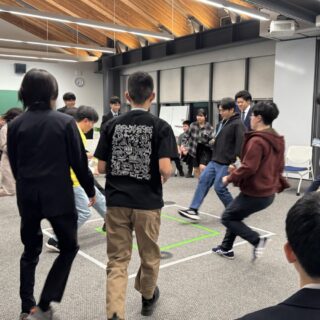Hello. I am Masaaki Shikada, ICT President.

On Thursday, April 24th, 2025, I helped plant Engineering Design II's "Kosen Beniharuka" seedlings for the third time. This time, I had a meeting at Kanazawa Campus, so I couldn’t travel to Hakusanroku Campus until after the meeting ended. By the time I arrived, the ridges had already been prepared and the planting had begun. This year I planted the second row from the west side. The soil was quite wet this winter due to the heavy snowfall, but I felt this made the work easier.
This is the third time I have planted seedlings, and although I am getting used to it, I still worry about whether the seedlings I planted will grow well. The year before last, the potatoes did not grow very large, probably because it rained a lot. Last year, good weather and moderate rainfall resulted in large potatoes. We expect this year's crop to be as good as last years.
All 2nd year students, Engineering Design II teachers, and Learning Mentors Domyson Abuan sensei and Sharmee Abuan sensei joined us to complete the seedling planting before 16:00. Then electric fences were installed and measures were taken to prevent damage from animals. We hope for another good harvest this year, following on from last year.
Our school will hold an open campus on Saturday, November 1st and Sunday, November 2nd. In conjunction with this event, the annual baked sweet potato sale will be held at the Sena Road Station. If you have time, please visit the Sena Road Station and try some potatoes!
Click here for more details about Open Campus
Masaaki Shikada
Getting to Know You
Pauline Baird an English teacher at ICT.
What is the thing you own but others use the most? Yes, you guessed it correctly. It is your name!
Students in their first classes are often nervous. Some parents at home are nervous, too, for a good reason because classes at ICT are in English. However, when the “Bridge English Chemistry” class began with an ice-breaker activity called “My Name …,” the class went from silent to a buzz of activity, with loud voices speaking Japanese and English and laughter.
My Name
“My name is Toshimune. I am ‘Toshi_____,’ my brother is ‘Toshi ____’, my father is ‘Toshi _____,’ and my grandfather is ‘Toshi _____.’ All men in my family have the “Toshi” [in the name],” one student was delighted to share. He was so happy telling and writing the story in his most beautiful English. The classroom atmosphere was transformed because the students were engaged.


Active Learning
First, for a pair work activity, students were asked to share a whiteboard to write their names. Doing so allowed them to complete a task together. They become less shy with others they just met less than a few weeks.
At first, students were puzzled when asked to share their first names by writing them in Kanji. To be honest, I couldn’t read their names in Kanji, yet I asked students to write their names in Kanji. Pair activities help students build bonds of friendship and create a shared experience that students and teachers need while learning and teaching English.
The next task was to tell us what their names meant and how they got their names. One student readily blurted out,
“I know. I know,” and began writing his name story in beautiful English on the whiteboard. He even shared a joke about the meaning of his name.
Others were unsure how they got their names, so I suggested:
“Ask your mama.”
In response, the class erupted in laughter. The students soon learned that I was serious.
“Take your phones and do research,” advised.
I followed up by saying,
“How about calling your parents?”
Soon, a few students were on the phone with their parents, telling them they were in English class and about the assignment.
In some instances, those students went from giggles to full-blown laughter. For example, one student laughed loudly and exclaimed,
“I learned something.” (Those words are like music to a teacher’s ears!)
The student learned that his grandfather loved a character in a TV drama, which is how he was given that same name. Others listened carefully and made notes, but everyone smiled. Students were happy on the first day of Bridge English Chemistry class.
Bridging Divides
This isn’t the first time I have done activities like this. I developed this practice many years, in the early 2000s, while working at Kanazawa Institute of Technology. Back then, I desperately needed to connect with my students, but I could not easily say or remember their names. Thus, I decided to use the name story, which has helped me since then.
Many Japanese people and students around the world have shared their name stories in every place I have taught and lived. I have learned that a person’s name is not just for identification. It is a powerful tool for building bonds among people, connecting with ourselves, situating oneself in one’s ancestry, and bridging home and school. The next time you wish to connect with someone or a student, it may be helpful to not stop at just learning a name. You might consider sharing your name story or asking about a person’s name story, if it feels correct and culturally appropriate. Everybody has a story!
~ Dr. Pauline Baird

As the last patches of snow melted from the Hakusanroku campus grounds and tiny buds of spring began to bloom, something else started fresh, too—our newest batch of freshmen!
Hi, I’m Domyson Abuan, one of the Learning Mentors (LMs) here at ICT, and our team works closely with both 1st and 2nd year students. This April 2025, we opened our doors to welcome the incoming students who are just beginning their journey of learning, growing, and living here at the Hakusanroku campus.
Each weeknight from 7:30 P.M. to 9:30 P.M., we run Learning Sessions (LS)—a time dedicated to studying, doing homework, and building good study habits for students. And of course, us LMs are there to guide, support, and sometimes, just be a friendly face to talk to.
To help our 1st year students ease into this new environment, we planned some fun and meaningful events to help them meet their schoolmates, and get a head start on the semester.
Kicking Things Off: Learning Session Orientation
On Friday, April 4th, both 1st and 2nd year students gathered for our LS Orientation. We LMs introduced ourselves and gave a quick rundown of what the session is all about. Just like their morning classes, LS has a set of guidelines so everyone knows how to make the most of their evenings.
One important part? English time! Students are encouraged to use English during LS so they can get used to it in preparation for their life in New Zealand when they are 3rd year students.
We also introduced this year’s new activity: a Reading Laboratory where students read an article suited to their current level and answer a few questions to sharpen their reading comprehension.
Afterwards, the 1st year students were given a short tour around the LS spaces—like where to find the announcements, where to grab study materials, and which rooms are used for quiet study and group work.
Then, the real fun began.
Games, Giggles, and Getting to Know Each Other
Back in the orientation room, it was time for some team-building games! First up was the Cup Stack Challenge. Divided into small groups, students had to work together using only a rubber band with strings (one per teammate) to stack paper cups into the tallest tower. With three rounds of fast-paced building, the room was filled with laughter, cheering, and a few dramatic cup crashes. Winners, of course, got snack prizes!
Next was English Bingo, with questions about hobbies and personal interests. The goal? Talk to as many classmates as possible to complete your bingo sheet. It was a great icebreaker and got everyone chatting in English, asking questions, and realizing they already have things in common.
To wrap things up, students worked together in groups to complete their STEM (Science subject) worksheets—an actual study task to help them prep for an upcoming quiz in their Chemistry class. They answered questions on laboratory safety and proper use of apparatus. We were really proud of how well they collaborated and focused, even after all the fun.
Welcome to the House System!
On Wednesday, April 9th, excitement was in the air as the students were sorted into their Houses! Think Hogwarts vibes, but with homework points instead of magic spells. As each student discovered their house, you could hear laughter and surprise (“Yay! I'm with you!”) across the room.
Meanwhile, the 2nd years, now seasoned pros, jumped right into earning points for their houses by completing homework and doing tasks. At the end of semester, the house with the most points wins the House Cup and a special reward. Let the friendly competition begin!
Karaoke, Board Games, and Bright Smiles
To officially welcome the new students, we held a Welcome Party on Friday, April 11th. The 2nd years really stepped up—they helped set up games and even kicked off the karaoke session!
One by one, students took the mic and sang their favorite hits. Many sang solo, some in groups, and others danced along. The room buzzed with energy and lots of laughter.
There were board games, card games, and stacking challenges too—each bringing out bursts of cheers. A computer game even pulled a huge crowd, and before long, many were playing and bonding like old friends.
Throughout the party, us teachers made our rounds, casually chatting with students in English about how they were settling in and what they looked forward to the most this semester - the chats were made more fun of course by delicious snacks.
A Springboard into Something Special
We hope these activities gave our freshmen a warm welcome and a strong start to their life here at Hakusanroku campus. With a new semester ahead, we're excited for more workshops, holiday events, and fun group challenges during our Learning Sessions.
And yes—we’ll definitely keep you posted.
Domyson Abuan

Hello, I am Yuuka Murai, a 3rd year student of ICT.It’s been about three weeks since I arrived in New Zealand, and my new life with my host family has been very fulfilling. The house I’m staying in faces Otago Harbour, and the view is amazing. I’ve been enjoying a lot of activities with my host mother and my 9-year-old host sister. We occasionally go for walks at the beach or in the park with the two dogs who live in another house. Since both Chloe, my host sister, and I are only children, it’s nice to have someone to hang around with. I’m also enjoying living with a cat for the first time in my life. On weekends, I usually hang out with friends in town or go out with other host families. I really love how easy it is to experience nature in Dunedin.
In Dunedin, buses are the main form of public transportation. I’ve used them several times, but I’m still not completely used to them. They often don’t come on time, they don’t run very often, and the schedule changes depending on whether it’s a weekday, weekend, or holiday, which can be a bit inconvenient. I want to make a habit of checking the timetable online in advance. Also, since there are no announcements on the bus, it can be hard to know when to get off. Until I get more used to it, I’m using a map app to check my location while on the bus, but I’ve ended up missing my stop a couple of times. Another big difference from Japan is the landscape. There are many steep hills, so walking between the house and the bus stop can be quite tiring—but it’s also a good way to get some exercise.
During the orientation program, I had a lot of free time, so I often took the opportunity to explore the city. Near the school, there’s an area with shops and malls. Prices are higher compared to Japan, so I’m trying to be more careful with my spending and avoid unnecessary purchases. The architecture and interior designs are stylish and fun to look at. I also see a lot of public art, which adds to the city's artistic vibe. In town, there are people from many different ethnic backgrounds. Many people dress casually, and both the city and the people have a relaxed and free-spirited atmosphere, which I find very comfortable.
Right now, we’re on Easter break. On the first day of the holiday, Chloe and I had a fun Easter egg hunt, looking for treats hidden around the house. Since Easter isn’t a major event in Japan, it was my first time experiencing it.
Classes are finally starting after the break. I’m a little nervous, but I’m looking forward to learning in this new environment. In addition to studying English, I hope to make the most of the opportunity to attend classes with local students and use it as a chance to grow. I also want to be mindful to switch between study, hobbies, and rest.
-

Ala Moana BeachAla Moana Beach
-

A wild sea lion spotted at Ala Moana BeachA wild sea lion spotted at Ala Moana Beach
-

The cat at my host family’s placeThe cat at my host family’s place
-
Dunedin Railway StationDunedin Railway Station
-
View from the front door of the houseView from the front door of the house
-
The street in front of the houseThe street in front of the house
 Hello! This is Yuri Makada from the Hakusanroku office. At ICT, 24 new students have arrived and are beginning to settle into their new campus life. This time, I would like to write the icebreaker activities held on Tuesday, April 1st, 2025, after the entrance ceremony.
Hello! This is Yuri Makada from the Hakusanroku office. At ICT, 24 new students have arrived and are beginning to settle into their new campus life. This time, I would like to write the icebreaker activities held on Tuesday, April 1st, 2025, after the entrance ceremony.
The first activity was a game called "Identity Crisis." Learning mentors handed out slips of paper to each student, with the name of another 1st and 2nd year student written on it. The mission was to find the person whose name was written on the paper. In addition, pieces of paper with students' names were also hidden under the chairs. At the end of the game, students had to find the chair with their own name written underneath and sit on it.
As the game began, students introduced themselves to each other while searching for the person on their paper. It took some time to find one another, but once they found their name, they seemed really happy with big smiles and the atmosphere became lively and cheerful.
It was also memorable to see students calling out to one another and then working together to find the chair with their own name on it.
-
Students introduced themselves to each other and checked whether the other person was holding the paper with their name on it.自己紹介し合い、相手が自分の名前が書かれた紙を持っているか確認
-
Checking names under the chairs. 椅子の裏の名前を確認
-
Found his name under a chair.椅子の裏に自分の名前を発見!
Next, a game called “In the Box” was held. The purpose of this was to find commonalities and hobbies among each other. First, students wrote their hobbies, hometowns, favorite foods, specialties, etc. on a piece of paper. The Learning Mentors then collected the papers and read out the contents one by one. If the students found something they had in common with what was read, they ran toward the center of the room.
In the center of the room, there were two tape outlines in the shape of 2 boxes, with the rule that if they entered the outer box, they received one coin, and if they entered the inter box, they received two coins. The students wrote a variety of information, such as “I like reading books,” “I like penguins,” “I like ICT,” etc. When information such as “I'm from Norway” or “I'm from Indonesia” was shared, the students responded with applause, creating a warm and friendly atmosphere.
At the end of the session, the three students with the highest number of coins were presented with snacks!
Through the icebreakers, the students seemed to be able to get to know each other better.
@ictkanazawa 2025年4月1日(火)、白山麓キャンパス(1、2年生)でアイスブレイクが行われ、共通点を見つけるゲームが実施されました👀✨緑の枠に入ると2ポイント、白い枠に入ると1ポイント付与され、ポイントの多い3名にはお菓子がプレゼントされました🍫🍪 学生たちは、アイスブレイクを通して、お互いを知ることができたのではないでしょうか✨ #国際高専
♬ ABC - Jackson 5
-
Write down hobbies, hometowns, favorite foods, special skills on a piece of paper.紙に自分の趣味や出身地、好きな食べ物、得意なことなどを記入
-
Run to the center box!自分に共通点があった場合、中央の枠に向かって走り出しました!
-
Get in the box!枠の中に入ります!
-
Received a coin!コインゲット!
-
The three winters!コインが多かった3名の学生!
Yuri Makada














